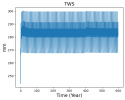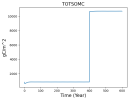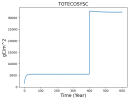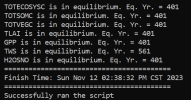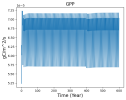Hello. Everyone.
I am carrying out the simulations of the carbon cycle and energy balance at single-point scale in subtropical forest. According to the tutorial (https://www2.cgd.ucar.edu/events/2019/ctsm/files/practical4-wieder.pdf), I spinup the case with AD mode and postAD. The atmospheric forcing data was from 2003-2009, 30-min. AD mode cycled the data for 400 years, and postAD cycled the same data for 200 years. Both output variables reached an equilibrium state by analysis from SpinupStability.ncl after postAD spinup.
Setting for AD spinup:
compset=I2000Clm50BgcCropGs
./xmlchange CLM_ACCELERATED_SPINUP="on"
./xmlchange CLM_FORCE_COLDSTART="on"
./xmlchange DATM_CLMNCEP_YR_START=2003
./xmlchange DATM_CLMNCEP_YR_END=2009
./xmlchange RUN_STARTDATE=0001-01-01
./xmlchange REST_OPTION=nyears
./xmlchange REST_N=400
Setting for exit spinup:
compset=I2000Clm50BgcCropGs
./xmlchange CLM_ACCELERATED_SPINUP="off"
./xmlchange CLM_FORCE_COLDSTART="off"
./xmlchange RUN_TYPE=startup
./xmlchange CONTINUE_RUN=FALSE
./xmlchange DATM_CLMNCEP_YR_START=2003
./xmlchange DATM_CLMNCEP_YR_END=2009
./xmlchange RUN_STARTDATE=0401-01-01
./xmlchange RUN_REFDATE=0401-01-01
./xmlchange REST_OPTION=nyears
./xmlchange REST_N=200
use_init_interp = .true.
finidat = '/path/to/2003-2009_400y.clm2.r.0401-01-01-00000.nc'
Normal case:
compset=I2000Clm50BgcCropGs
./xmlchange CLM_ACCELERATED_SPINUP="off"
./xmlchange CLM_FORCE_COLDSTART="off"
./xmlchange RUN_TYPE=startup
./xmlchange CONTINUE_RUN=FALSE
./xmlchange DATM_CLMNCEP_YR_START=2010
./xmlchange DATM_CLMNCEP_YR_ALIGN=2010
./xmlchange DATM_CLMNCEP_YR_END=2010
./xmlchange STOP_OPTION=nyears
./xmlchange STOP_N=1
./xmlchange RUN_STARTDATE=2010-01-01
./xmlchange CLM_CO2_TYPE='constant'
./xmlchange CCSM_CO2_PPMV=388.8
use_init_interp = .true.
finidat = '/path/to/2003-2009_200y.clm2.r.0601-01-01-00000.nc'
However, when I set the initial file from postAD spinup, and then ran a case from 2010-01-01, the simulations of GPP, latent heat, and sensible heat made sense. The NEE and soil respiration were higher than the observation data. I also compared all these data between spinup(400y-200y) and no spinup conditions. Even no spinup, NEE and soil respiration looked well with the monitoring data. After spinup, NEE became positive while it was negative in both no spinup and real case.
I guess the abnormal thing was caused by soil water because deep soil water simulated with spinup was much lower than that without no spinup. One thing that need to be noted, TWS reached equilibrium in post AD spinup, but could not reach stable even when I extended AD spinup time to 1000 years.
Can anyone help me or give me any suggestions on carbon cycle modeling using CLM5.0? Thanks a lot.
The results for AD spinup and postAD spinup using SpinupStability.ncl were attached. Also the variables related to carbon.
I am carrying out the simulations of the carbon cycle and energy balance at single-point scale in subtropical forest. According to the tutorial (https://www2.cgd.ucar.edu/events/2019/ctsm/files/practical4-wieder.pdf), I spinup the case with AD mode and postAD. The atmospheric forcing data was from 2003-2009, 30-min. AD mode cycled the data for 400 years, and postAD cycled the same data for 200 years. Both output variables reached an equilibrium state by analysis from SpinupStability.ncl after postAD spinup.
Setting for AD spinup:
compset=I2000Clm50BgcCropGs
./xmlchange CLM_ACCELERATED_SPINUP="on"
./xmlchange CLM_FORCE_COLDSTART="on"
./xmlchange DATM_CLMNCEP_YR_START=2003
./xmlchange DATM_CLMNCEP_YR_END=2009
./xmlchange RUN_STARTDATE=0001-01-01
./xmlchange REST_OPTION=nyears
./xmlchange REST_N=400
Setting for exit spinup:
compset=I2000Clm50BgcCropGs
./xmlchange CLM_ACCELERATED_SPINUP="off"
./xmlchange CLM_FORCE_COLDSTART="off"
./xmlchange RUN_TYPE=startup
./xmlchange CONTINUE_RUN=FALSE
./xmlchange DATM_CLMNCEP_YR_START=2003
./xmlchange DATM_CLMNCEP_YR_END=2009
./xmlchange RUN_STARTDATE=0401-01-01
./xmlchange RUN_REFDATE=0401-01-01
./xmlchange REST_OPTION=nyears
./xmlchange REST_N=200
use_init_interp = .true.
finidat = '/path/to/2003-2009_400y.clm2.r.0401-01-01-00000.nc'
Normal case:
compset=I2000Clm50BgcCropGs
./xmlchange CLM_ACCELERATED_SPINUP="off"
./xmlchange CLM_FORCE_COLDSTART="off"
./xmlchange RUN_TYPE=startup
./xmlchange CONTINUE_RUN=FALSE
./xmlchange DATM_CLMNCEP_YR_START=2010
./xmlchange DATM_CLMNCEP_YR_ALIGN=2010
./xmlchange DATM_CLMNCEP_YR_END=2010
./xmlchange STOP_OPTION=nyears
./xmlchange STOP_N=1
./xmlchange RUN_STARTDATE=2010-01-01
./xmlchange CLM_CO2_TYPE='constant'
./xmlchange CCSM_CO2_PPMV=388.8
use_init_interp = .true.
finidat = '/path/to/2003-2009_200y.clm2.r.0601-01-01-00000.nc'
However, when I set the initial file from postAD spinup, and then ran a case from 2010-01-01, the simulations of GPP, latent heat, and sensible heat made sense. The NEE and soil respiration were higher than the observation data. I also compared all these data between spinup(400y-200y) and no spinup conditions. Even no spinup, NEE and soil respiration looked well with the monitoring data. After spinup, NEE became positive while it was negative in both no spinup and real case.
I guess the abnormal thing was caused by soil water because deep soil water simulated with spinup was much lower than that without no spinup. One thing that need to be noted, TWS reached equilibrium in post AD spinup, but could not reach stable even when I extended AD spinup time to 1000 years.
Can anyone help me or give me any suggestions on carbon cycle modeling using CLM5.0? Thanks a lot.
The results for AD spinup and postAD spinup using SpinupStability.ncl were attached. Also the variables related to carbon.


